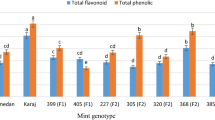Summary
Most Mentha species have 1–25% 1-limonene and 0.5–8% 1,8-cineole, but 19 individuals having more than 50% limonene-cineole were found in a progeny of 10,000 Strain 2 M. citrata — M. crispa F 1 hybrids. When the same strain of M. citrata (2 n = 96) having the genotype I1I1 i 2 i 2, a lavender herbage odor with oil assaying 30% linalool and 58.5% linalyl acetate, is hybridized with the closely related octoploid species M. aquatica (2 n = 96) having the genotype i 1 i 1 i 2 i 2, a menthofuran herbage odor with oil assaying 65–80% menthofuran, the fertile F 1 hybrids should have the genotype I 1 i 1 i 2 i 2 and a lavender odor with oil assaying 84–90% linalool — linalyl acetate. In addition to 111 normal lavender-odored hybrids, this cross gave one individual (Strain 38) having 20.4% limonene and 36.4% cineole and one individual (Strain 625) having 67.5% limonene and 23.6% cineole. Since M. aquatica is homozygous for menthofuran production, and since Strain 38 — M. aquatica backcross progenies had the disomic ratio of 1 limonene and cineole-odored: 1 methofuran-odored, it is evident that the 57% limonene — cineole content of Strain 38 is due to a single dominant gene Lm. Strains 38 and 625 were hybridized with other tester species having known genotypes for other oil constituents to demonstrate that the gene Lm prevents the conversion of limonene to more advanced compounds, namely: carvone, pulegone, methofuran, menthone, menthol, and menthyl acetate which are normally developed in the oil of other species having the recessive gene lm. Strain 38 hybrids with M. citrata show that the dominant I gene interrupts oil biogenesis at an earlier stage than the Lm gene and largely prevents the synthesis of limonene and cineole. Nine of 21 strains having 57– 94% limonene — cineole were investigated. Strains 38 and 62 had the genotype i 1 i 1 i 2 i 2 Lm 1 lm 1 lm 2 lm 2 or i 1 i 1 i 2 i 2 lm 1 lm 1 Lm 2 lm 2, whereas Strain 625 and six others had the genotype i 1 i 1 i 2 i 2 Lm 1 lm 1 Lm 2 1m 2. These segregants from the segmental allopolyploids may be explained by assuming that M. aquatica has the genotype \(\frac{{lm{\text{ - }}A{\text{ - }}i}}{{lm{\text{ - }}A{\text{ - }}i}}\frac{{lm{\text{ - }}a{\text{ - }}i}}{{lm{\text{ - }}a{\text{ - }}i}}\) and Strain 2 of M. citrata the genotype \(\frac{{Lm{\text{ - }}A{\text{ - }}I}}{{Lm{\text{ - }}A{\text{ - }}I}}\frac{{lm{\text{ - }}a{\text{ - }}i}}{{lm{\text{ - }}a{\text{ - }}i}}\) with A and a designating the non-homologous centromere regions of the two chromosome pairs carrying the linked genes on different chromosome arms. Crossing over between the genes would not be detectible when there is normal autosyndetic bivalent pairing, whereas occasional quadrivalent pairing of the four chromosomes of Strain 2 of M. citrata could lead to gene interchanges between chromosomes non-homologous for the centromere region.
Similar content being viewed by others
Literature
Arctander, S.: Perfume and Flavor Chemicals (Aroma Chemicals). Arctander, Montclair, N.J. Vol. II. 1969.
Fujita, Y.: Problems in the genus Mentha (II) (in Japanese). Koryo 58, 15–20 (1960a).
Fujita, Y.: Problems in the genus Mentha (III) (in Japanese). Koryo 59, 41–42 (1960b).
Fujita, Y.: Problems in the genus Mentha (IV) (in Japanese). Koryo 61, 43–46 (1961).
Handa, K. L., Smith, D. M., Nigam, I. C., Levi, L.: Essential oils and their constituents XXIII. Chemotaxonomy of the genus Mentha. J. Pharm. Sci. 53, 1407–1409 (1964).
Hefendehl, F. W.: Zusammensetzung des ätherischen Öls von Mentha aquatica L. Beiträge zur Terpenbiogenese. Arch. der Pharm. 300, 438–448 (1967).
Ikeda, N.: Thremmatological Investigation of the Genus Mentha by Means of Cytogenetics (in Japanese with English summary). Okayama, Japan: Fac. of Agr. Okayama Univ. 1961.
Murray, M. J.: The genetic basis for a third ketone group in Mentha spicata L. Genetics 45, 931–937 (1960).
Murray, M. J., Lincoln, D. E.: The genetic basis of acyclic oil constituents in Mentha citrata Ehrh. Genetics 65, 457–471 (1970).
Reitsema, R. H.: A biogenetic arrangement of mint species. J. Am. Pharm. Assoc. 47, 267–269 (1958).
Ruttle, M. L.: Cytological and embryological studies on the genus Mentha. Gartenbauwissenschaft 4, 428–468 (1931).
Shimizu, S., Karasawa, D., Ikeda, N.: A new mint (variety of Mentha aquatica L.) containing (—)-isopinocamphone as a major constituent of essential oil. Agr. Biol. Chem. 30, 200–201 (1966).
Smith, D. M., Skakum, W., Levi, L.: Determination of botanical and geographical origin of spearmint oils by gas chromatographic and ultraviolet analysis. J. Agr. Food Chem. 11, 268–276 (1963).
Todd, W. A., Murray, M. J.: New essential oils from hybridization of Mentha citrata Ehrh. Perfumery Essent. Oil Record 59, 97–102 (1968).
Author information
Authors and Affiliations
Additional information
Communicated by R. W. Allard
Research Assistant, Research Assistant, Senior Chemist, and Director of Plant Research respectively.
Rights and permissions
About this article
Cite this article
Lincoln, D.E., Marble, P.M., Cramer, F.J. et al. Genetic basis for high limonene—cineole content of exceptional Mentha citrata hybrids. Theoret. Appl. Genetics 41, 365–370 (1971). https://doi.org/10.1007/BF00277337
Received:
Issue Date:
DOI: https://doi.org/10.1007/BF00277337




